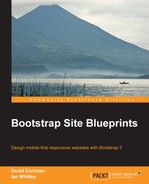If our workflow is to be truly mobile friendly, we need a good responsive image technique. In this exercise, we'll implement one of the current leading techniques to improve both the performance and the design of the portfolio carousel implemented in Chapter 2, Bootstrappin' Your Portfolio.
If you recall from Chapter 2, Bootstrappin' Your Portfolio, the carousel images are crafted to fill a full-width layout. The images are 1,600 pixels wide and weigh in between 135 to 189 KB. To send these same images to phones and small non-retina tablets is overkill. In an age of mobile-first responsive design, it's irresponsible.
Furthermore, if you stop and look at the design on a narrow viewport, you may realize that your carousel would look better if the images were a bit taller and narrower, allowing them to fill more of the vertical space we have available on a narrow screen.
At a phone-width viewport, our images—which are crafted for wide screens—may work, but they would work better if they made use of more of our available vertical space. This can be seen in the following screenshot:

A good responsive images technique will allow us to provide exactly the images we need for narrow viewports, answering the need for smaller file sizes and quicker load times as well as improved design.
